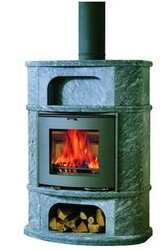Gentlemen, gentlemen:
Comparing a woodburning metal stove having some masonry (soapstone or other) panels and a masonry heater is not comparing apples-to-apples. They are very different.
The major difference involves understanding the concept of "thermal mass" heating. Masonry heaters are thermal mass (storage) heaters. Woodburning stoves are not. It is this significant weight (mass) of masonry that determines, along with the temperature of the mass achieved by the burned fuel load, the amount of heat that can be stored by a true masonry heater (definitions below) and then slowly released into the room. The addition of masonry panels on a metal stove help delay the heat loss a little.
Another major difference in the two heaters is the fire. Masonry heaters have the technology to be able to burn wood at high enough temperatures (1800* - 2000* F) to allow quite complete and clean combustion of wood and simultaneously store the heat in the body of the stove for "long term dissipation". The masonry heater is designed to burn a "load" of wood without baffeling down the incoming air, and then go out. Again, these are major differences with woodburning metal stoves which would be severely damaged by so firing.
The Standard Guide for Construction of Solid Fuel Burning Masonry Heaters ASTM E 1602-94, published by the American Society for Testing and Materials, gives the following definition:
Section 3.2.14 – masonry heater – a vented heating system of predominantly masonry construction having a mass of at least 800 kg (1760 lbs), excluding the chimney and masonry heater base. In particular a masonry heater designed specifically to capture and store a substantial portion of the heat energy from a charge of solid fuel mixed with a adequate amount of air to burn rapidly and more completely at high temperatures in order to reduce emission of unburned hydrocarbons; and be constructed of sufficient mass and surface area such that under normal operating conditions, the external surface temperature of the masonry heater (except the region immediately surrounding the fuel loading door(s), does not exceed 110°C (230°F).
As far as emissions are concerned, to meet the EPA requirements a masonry heater must conform to the following:
1. A masonry heater is a solid fuelled heating system of predominantly masonry construction having a mass of at least 800 kg (1760 lb) (excluding chimney and foundation), and having an overall average wall thickness of not more than 250 mm (10 in.). It achieves heat storage by the routing of exhaust gases through internal heat exchange channels in which the flow path downstream of the firebox includes at least one 180 degree change in flow direction, usually downward, before entering the chimney. The shortest distance between the firebox exit and chimney entrance is not less than twice the largest firebox dimension. It is equipped with doors that are intended to be in the closed position during the burn cycle. Its combustion air supply system is configured to produce a burn rate greater than five kilograms of fuel per hour. The chimney has a maximum flue size of 8 in. x 12 in. (200 mm x 300 mm) nominal rectangular dimensions, or 8 in. (200 mm) round.
2. The masonry heater is constructed by a person who holds a valid certificate of qualification issued by the Masonry Heater Association of North America, or the holder of such a certificate verifies in writing that the heater complies in all respects with item 1. above. Proposed language is for the acceptance of masonry heaters in sensitive airsheds.
Comparision on Masonry Heaters with Other Woodburning Appliances
1998 “Best Professional Judgement” Emission Rates (EPA-600/R-98-174a):
Appliance type Smoke g/kg
Conventional fireplace 17.3
Conventional Stove 18.5
EPA certified non-catalytic stove 6.0
EPA certified catalytic stove 6.2
Masonry heater 3.0
References
1. J.E.Houck and P.E.Tiegs Residential Wood Combustion Technology Review, Volume 1. Technical Report, EPA-600/R-98-174a, December 1998.
http://mha-net.org/docs/rwc01.PDF
2. R. Jaasma, J. W. Shelton and C. H. Stern, Final Report on Masonry Heater Emissions Test Method Development, Wood Heating Alliance, Washington, 1990
3.
www.vermontwoodstove.com/planning
4. Oregon, Interpretive Ruling No. 93-47, Masonry Heater Radiant Heating Systems (rev 05/01/00, ed. only)
Aye,
Marty


